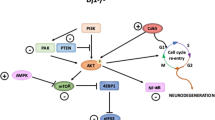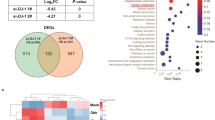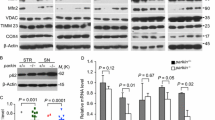Abstract
The molecular mechanisms responsible for the loss of dopaminergic neurons in Parkinson’s disease (PD) remain obscure. Loss of function of E3 ubiquitin ligases is associated with mitochondria dysfunction, dysfunction of protein degradation, and α-synuclein aggregation, which are major contributors to neurodegeneration in PD. Recent research has thus focused on E3 ubiquitin ligase glycoprotein 78 (GP78); however, the role of GP78 in PD pathogenesis remains unclear. Notably, cyclin-dependent kinase 5 (CDK5) controls multiple cellular events in postmitotic neurons, and CDK5 activity has been implicated in the pathogenesis of PD. Thus, we addressed the relationship between CDK5 and GP78 in MPTP-based PD models. We found that GP78 expression is decreased in MPTP-based cellular and animal PD models, and CDK5 directly phosphorylated GP78 at Ser516, which promoted the ubiquitination and degradation of GP78. Importantly, overexpression of GP78 or interference of GP78 Ser516 phosphorylation protected neurons against MPP+-induced cell death. Thus, our research reveals that the CDK5-GP78 pathway is involved in the pathogenesis of PD and could be a novel candidate drug target for the treatment of PD.





Similar content being viewed by others
References
Dawson TM, Dawson VL (2003) Molecular pathways of neurodegeneration in Parkinson’s disease. Science 302(5646):819–822. doi:10.1126/science.1087753
Moore DJ, West AB, Dawson VL, Dawson TM (2005) Molecular pathophysiology of Parkinson’s disease. Annu Rev Neurosci 28:57–87. doi:10.1146/annurev.neuro.28.061604.135718
Cookson MR (2005) The biochemistry of Parkinson’s disease. Annu Rev Biochem 74:29–52. doi:10.1146/annurev.biochem.74.082803.133400
Shimura H, Hattori N, Kubo S, Mizuno Y, Asakawa S, Minoshima S, Shimizu N, Iwai K et al (2000) Familial Parkinson disease gene product, parkin, is a ubiquitin-protein ligase. Nat Genet 25(3):302–305. doi:10.1038/77060
Farrer M, Chan P, Chen R, Tan L, Lincoln S, Hernandez D, Forno L, Gwinn-Hardy K et al (2001) Lewy bodies and parkinsonism in families with parkin mutations. Ann Neurol 50(3):293–300
Khan NL, Graham E, Critchley P, Schrag AE, Wood NW, Lees AJ, Bhatia KP, Quinn N (2003) Parkin disease: a phenotypic study of a large case series. Brain 126(Pt 6):1279–1292
Ren Y, Zhao J, Feng J (2003) Parkin binds to alpha/beta tubulin and increases their ubiquitination and degradation. J Neurosci 23(8):3316–3324
Nardin A, Schrepfer E, Ziviani E (2016) Counteracting PINK/Parkin deficiency in the activation of mitophagy: a potential therapeutic intervention for Parkinson’s disease. Curr Neuropharmacol 14(3):250–259
Jones R (2010) The roles of PINK1 and Parkin in Parkinson’s disease. PLoS Biol 8(1):e1000299. doi:10.1371/journal.pbio.1000299
Kondapalli C, Kazlauskaite A, Zhang N, Woodroof HI, Campbell DG, Gourlay R, Burchell L, Walden H et al (2012) PINK1 is activated by mitochondrial membrane potential depolarization and stimulates Parkin E3 ligase activity by phosphorylating serine 65. Open Biol 2(5):120080. doi:10.1098/rsob.120080
Zhuang N, Li L, Chen S, Wang T (2016) PINK1-dependent phosphorylation of PINK1 and Parkin is essential for mitochondrial quality control. Cell Death Dis 7(12):e2501. doi:10.1038/cddis.2016.396
Lee JT, Wheeler TC, Li L, Chin LS (2008) Ubiquitination of alpha-synuclein by Siah-1 promotes alpha-synuclein aggregation and apoptotic cell death. Hum Mol Genet 17(6):906–917. doi:10.1093/hmg/ddm363
Cai ZL, Xu J, Xue SR, Liu YY, Zhang YJ, Zhang XZ, Wang X, Wu FP et al (2015) The E3 ubiquitin ligase seven in absentia homolog 1 may be a potential new therapeutic target for Parkinson’s disease. Neural Regen Res 10(8):1286–1291. doi:10.4103/1673-5374.162763
Fang S, Ferrone M, Yang C, Jensen JP, Tiwari S, Weissman AM (2001) The tumor autocrine motility factor receptor, gp78, is a ubiquitin protein ligase implicated in degradation from the endoplasmic reticulum. Proc Natl Acad Sci U S A 98(25):14422–14427. doi:10.1073/pnas.251401598
Christianson JC, Olzmann JA, Shaler TA, Sowa ME, Bennett EJ, Richter CM, Tyler RE, Greenblatt EJ et al (2011) Defining human ERAD networks through an integrative mapping strategy. Nat Cell Biol 14(1):93–105. doi:10.1038/ncb2383
Nabi IR, Watanabe H, Raz A (1990) Identification of B16-F1 melanoma autocrine motility-like factor receptor. Cancer Res 50(2):409–414
Chen B, Mariano J, Tsai YC, Chan AH, Cohen M, Weissman AM (2006) The activity of a human endoplasmic reticulum-associated degradation E3, gp78, requires its cue domain, RING finger, and an E2-binding site. Proc Natl Acad Sci U S A 103(2):341–346. doi:10.1073/pnas.0506618103
Li W, Tu D, Li L, Wollert T, Ghirlando R, Brunger AT, Ye Y (2009) Mechanistic insights into active site-associated polyubiquitination by the ubiquitin-conjugating enzyme Ube2g2. Proc Natl Acad Sci U S A 106(10):3722–3727. doi:10.1073/pnas.0808564106
Zhong X, Shen Y, Ballar P, Apostolou A, Agami R, Fang S (2004) AAA ATPase p97/valosin-containing protein interacts with gp78, a ubiquitin ligase for endoplasmic reticulum-associated degradation. J Biol Chem 279(44):45676–45684. doi:10.1074/jbc.M409034200
Kostova Z, Tsai YC, Weissman AM (2007) Ubiquitin ligases, critical mediators of endoplasmic reticulum-associated degradation. Semin Cell Dev Biol 18(6):770–779. doi:10.1016/j.semcdb.2007.09.002
Tsai YC, Mendoza A, Mariano JM, Zhou M, Kostova Z, Chen B, Veenstra T, Hewitt SM et al (2007) The ubiquitin ligase gp78 promotes sarcoma metastasis by targeting KAI1 for degradation. Nat Med 13(12):1504–1509. doi:10.1038/nm1686
Ying Z, Wang H, Fan H, Zhu X, Zhou J, Fei E, Wang G (2009) Gp78, an ER associated E3, promotes SOD1 and ataxin-3 degradation. Hum Mol Genet 18(22):4268–4281. doi:10.1093/hmg/ddp380
Fu M, St-Pierre P, Shankar J, Wang PT, Joshi B, Nabi IR (2013) Regulation of mitophagy by the Gp78 E3 ubiquitin ligase. Mol Biol Cell 24(8):1153–1162. doi:10.1091/mbc.E12-08-0607
Jacobs JL, Zhu J, Sarkar SN, Coyne CB (2014) Regulation of mitochondrial antiviral signaling (MAVS) expression and signaling by the mitochondria-associated endoplasmic reticulum membrane (MAM) protein Gp78. J Biol Chem 289(3):1604–1616. doi:10.1074/jbc.M113.520254
Avraham E, Szargel R, Eyal A, Rott R, Engelender S (2005) Glycogen synthase kinase 3beta modulates synphilin-1 ubiquitylation and cellular inclusion formation by SIAH: implications for proteasomal function and Lewy body formation. J Biol Chem 280(52):42877–42886. doi:10.1074/jbc.M505608200
Kazlauskaite A, Martinez-Torres RJ, Wilkie S, Kumar A, Peltier J, Gonzalez A, Johnson C, Zhang J et al (2015) Binding to serine 65-phosphorylated ubiquitin primes Parkin for optimal PINK1-dependent phosphorylation and activation. EMBO Rep 16(8):939–954. doi:10.15252/embr.201540352
Tian B, Yang Q, Mao Z (2009) Phosphorylation of ATM by Cdk5 mediates DNA damage signalling and regulates neuronal death. Nat Cell Biol 11(2):211–218. doi:10.1038/ncb1829
Jessberger S, Gage FH, Eisch AJ, Lagace DC (2009) Making a neuron: Cdk5 in embryonic and adult neurogenesis. Trends Neurosci 32(11):575–582. doi:10.1016/j.tins.2009.07.002
Cheung ZH, Ip NY (2012) Cdk5: a multifaceted kinase in neurodegenerative diseases. Trends Cell Biol 22(3):169–175. doi:10.1016/j.tcb.2011.11.003
Zhang P, Shao XY, Qi GJ, Chen Q, Bu LL, Chen LJ, Shi J, Ming J et al (2016) Cdk5-dependent activation of neuronal Inflammasomes in Parkinson’s disease. Mov Disord 31(3):366–376. doi:10.1002/mds.26488
Avraham E, Rott R, Liani E, Szargel R, Engelender S (2007) Phosphorylation of Parkin by the cyclin-dependent kinase 5 at the linker region modulates its ubiquitin-ligase activity and aggregation. J Biol Chem 282(17):12842–12850. doi:10.1074/jbc.M608243200
Lahav-Baratz S, Sudakin V, Ruderman JV, Hershko A (1995) Reversible phosphorylation controls the activity of cyclosome-associated cyclin-ubiquitin ligase. Proc Natl Acad Sci U S A 92(20):9303–9307
Qi GJ, Chen Q, Chen LJ, Shu Y, Bu LL, Shao XY, Zhang P, Jiao FJ et al (2016) Phosphorylation of Connexin 43 by Cdk5 modulates neuronal migration during embryonic brain development. Mol Neurobiol 53(5):2969–2982. doi:10.1007/s12035-015-9190-6
Ahn JS, Ann EJ, Kim MY, Yoon JH, Lee HJ, Jo EH, Lee K, Lee JS et al (2016) Autophagy negatively regulates tumor cell proliferation through phosphorylation dependent degradation of the Notch1 intracellular domain. Oncotarget. doi:10.18632/oncotarget.12986
Lee S, Wang JW, Yu W, Lu B (2012) Phospho-dependent ubiquitination and degradation of PAR-1 regulates synaptic morphology and tau-mediated Abeta toxicity in Drosophila. Nat Commun 3:1312. doi:10.1038/ncomms2278
Kuntzel H, Pieniazek NJ, Pieniazek D, Leister DE (1975) Lipophilic proteins encoded by mitochondrial and nuclear genes in Neurospora crassa. Eur J Biochem 54(2):567–575
Soustre L, Diard F, Larroude C, Delorme G (1972) Primary pulmonary forms of histiocytosis in adults. J Radiol Electrol Med Nucl 53(11):837–838
Liu SL, Wang C, Jiang T, Tan L, Xing A, Yu JT (2016) The role of Cdk5 in Alzheimer’s disease. Mol Neurobiol 53(7):4328–4342. doi:10.1007/s12035-015-9369-x
Piedrahita D, Hernandez I, Lopez-Tobon A, Fedorov D, Obara B, Manjunath BS, Boudreau RL, Davidson B et al (2010) Silencing of CDK5 reduces neurofibrillary tangles in transgenic Alzheimer’s mice. J Neurosci 30(42):13966–13976. doi:10.1523/JNEUROSCI.3637-10.2010
Maestre C, Delgado-Esteban M, Gomez-Sanchez JC, Bolanos JP, Almeida A (2008) Cdk5 phosphorylates Cdh1 and modulates cyclin B1 stability in excitotoxicity. EMBO J 27(20):2736–2745. doi:10.1038/emboj.2008.195
Llambi F, Wang YM, Victor B, Yang M, Schneider DM, Gingras S, Parsons MJ, Zheng JH et al (2016) BOK is a non-canonical BCL-2 family effector of apoptosis regulated by ER-associated degradation. Cell 165(2):421–433. doi:10.1016/j.cell.2016.02.026
Wang Y, Ha SW, Zhang T, Kho DH, Raz A, Xie Y (2014) Polyubiquitylation of AMF requires cooperation between the gp78 and TRIM25 ubiquitin ligases. Oncotarget 5(8):2044–2051. doi:10.18632/oncotarget.1478
Acknowledgments
This work was supported financially by the National Natural Science Foundation of China (Nos. 31371384 and 31571044 to B.T. and No. 31600821 to P.Z.), Program for New Century Excellent Talents in University (No. NCET-10-0415 to B.T.), and China Postdoctoral Scientific Foundation (No. 2015M582226 to P.Z.).
Author information
Authors and Affiliations
Corresponding author
Ethics declarations
All animal experiments were approved by the Institutional Animal Care and Use Committees of Huazhong University of Science and Technology.
Conflict of Interest
The authors declare that they have no conflicts of interest.
Rights and permissions
About this article
Cite this article
Wang, Q., Jiao, F., Zhang, P. et al. CDK5-Mediated Phosphorylation-Dependent Ubiquitination and Degradation of E3 Ubiquitin Ligases GP78 Accelerates Neuronal Death in Parkinson’s Disease. Mol Neurobiol 55, 3709–3717 (2018). https://doi.org/10.1007/s12035-017-0579-2
Received:
Accepted:
Published:
Issue Date:
DOI: https://doi.org/10.1007/s12035-017-0579-2




